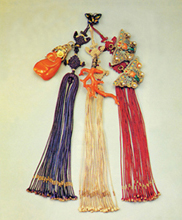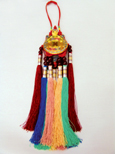 In Korea, a long time ago, high-class people's daughters or wives had an accessory called norigae. It was put on a jacket coat string or on the waist of a women's skirt. It had very gorgeous colors and nice looks. It could be used as an accessory, as a perfume, or as a gift for marriage.
In Korea, a long time ago, high-class people's daughters or wives had an accessory called norigae. It was put on a jacket coat string or on the waist of a women's skirt. It had very gorgeous colors and nice looks. It could be used as an accessory, as a perfume, or as a gift for marriage.Norigaes consist of four parts: the strings, the main ornamentation, the knots, and the tassels. The strings are a kind of ring to connect the main ornamentation. There is usually one ornamentation, but there can sometimes be three. The knot's purpose is for decoration. They give more beauty to the norigae above and below the main ornamentation. The tassel is hung under the bottom. The color of the knots and tassels are red, deep blue and yellow. Their size depends on the size and shape of the main ornamentation. The jewels can be gold, silver, white gem, coral, or jade. The main ornamentation can come in many shapes: square, rectangular, round, or even like a flower. The color is based on red, dark blue, and yellow, but lots of various colors are used.
 The biggest norigaes were luxury items that were used at the royal court. The next biggest norigaes were for the high class. The smallest norigaes were for young married women and girls. The higher a woman's class, the bigger and more gorgeous was her norigae. Common women wore norigaes with silver everyday, and they wore special norigaes for marriage ceremonies and congratulations at home. Norigaes for girls are quite colorful. They can be pink, green, and yellow.
The biggest norigaes were luxury items that were used at the royal court. The next biggest norigaes were for the high class. The smallest norigaes were for young married women and girls. The higher a woman's class, the bigger and more gorgeous was her norigae. Common women wore norigaes with silver everyday, and they wore special norigaes for marriage ceremonies and congratulations at home. Norigaes for girls are quite colorful. They can be pink, green, and yellow.The norigae had practical uses. Incense norigaes, which had musk, protected women from snakes and helped to relax the body in case of digestive upsets. The mixture included water and musk, so drinking it helped to relax the body. The ornamentation could also be a silver knife that was used by women to kill themselves or fight against their enemies for protection. Women liked to keep perfume like today. In the past, norigaes were made by mixing various perfume powders which made the perfume spread up around a women's body in contrast with today's liquid perfume. According to ancient records, the grinding of pumpkins with gold from a norigae helped to stop bleeding. In these cases, keeping norigaes on the body prepared women for living with a womanly virtue. Norigaes were not just luxury items.
From the royal court and high class to common people, women handed over their precious norigaes to their daughters and daughters-in-law as a family treasure. People put their wishes into their norigaes. They wished for things like riches, high rankings, fertility, health, and long lives.
